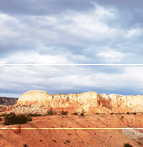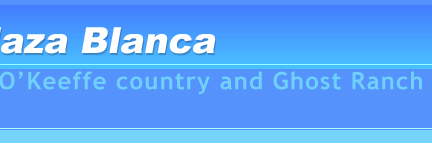Photography at Plaza Blanca - Capturing O'Keeffe's White Place
Plaza Blanca represents one of the American Southwest's most photographically rewarding destinations, offering the same dramatic contrasts, sculptural forms, and ethereal lighting that inspired Georgia O'Keeffe's most celebrated paintings. The white limestone formations provide unique challenges and opportunities for photographers, requiring specialized techniques to capture their full beauty while dealing with extreme contrast and harsh desert conditions.
Understanding the Photographic Challenges
Extreme Dynamic Range: The brilliant white limestone formations against often dark desert backgrounds and deep blue skies create exposure challenges that push camera sensors to their limits. Successful photography requires understanding how to manage these extreme contrasts while preserving detail in both highlights and shadows.
High Desert Lighting: At over 6,000 feet elevation, the thin atmosphere provides little filtering of intense UV radiation, creating harsh midday lighting that can wash out detail and eliminate the subtle textures that make these formations so compelling. The high altitude also intensifies color saturation, requiring careful white balance and exposure management.
Environmental Extremes: Desert photography equipment faces challenges from wind-blown sand, extreme temperature variations, and intense solar radiation. Protecting gear while maintaining accessibility for changing lighting conditions requires careful planning and appropriate protective measures.
Optimal Timing for Photography
Golden Hour Magic
Morning Light (7:00-9:00 AM): Early morning provides some of the most spectacular lighting conditions, with low-angle sunlight skimming across the white formations to create dramatic texture and three-dimensional modeling. The cooler morning air also provides better atmospheric clarity for sharp, detailed images.
Evening Glory (5:00-7:00 PM): Late afternoon light often produces the most dramatic color contrasts, with warm sunlight on white formations against deep blue skies. However, timing is critical - arrive by 4:30 PM to scout compositions before optimal lighting begins, as conditions change rapidly.
Seasonal Considerations: Winter months provide longer periods of optimal lighting due to the sun's lower angle throughout the day, while summer visits require more precise timing to capture brief periods of quality light.
The "Blue Hour" Opportunities
Pre-Dawn and Post-Sunset: The twilight periods before sunrise and after sunset can produce ethereal images with the white formations glowing against deep blue skies. Long exposures during these periods can create surreal, otherworldly effects that emphasize the formations' sculptural qualities.
Technical Camera Settings and Techniques
Exposure Strategy
Histogram Management: With white formations as primary subjects, protecting highlights becomes crucial. Expose to the right (ETTR) technique helps maximize image quality, but watch for clipping in the formation details. Use exposure compensation of -1/3 to -2/3 stops to preserve highlight detail, then recover shadows in post-processing.
Dynamic Range Optimization: Shoot in RAW format to maximize post-processing flexibility. Consider graduated neutral density filters to balance bright skies with darker foregrounds, or bracket exposures for HDR processing when single exposures cannot capture the full range.
Focus Stacking for Maximum Sharpness: The sculptural nature of Plaza Blanca's formations often requires extensive depth of field. Focus stacking techniques allow shooting at optimal apertures (f/8-f/11) while achieving front-to-back sharpness impossible with hyperfocal distance focusing alone.
Specialized Filter Applications
Polarizing Filters: Essential for managing reflections off light-colored rock surfaces and deepening blue skies for increased contrast. Experiment with partial polarization to maintain some atmospheric haze while reducing glare from formation surfaces.
Neutral Density Options: Variable ND filters enable creative long exposures for cloud movement and atmospheric effects. Graduated ND filters help balance extreme brightness differences between formations and sky without compromising composition flexibility.
UV and Haze Filters: The high elevation and intense desert sun make UV filtration beneficial for both image quality and lens protection. Quality UV filters reduce atmospheric haze while protecting expensive lens elements from wind-blown sand.
Composition Strategies
Emphasizing Scale and Drama
Foreground Elements: Include desert plants, interesting rocks, or human figures to provide scale reference for the massive formations. Cholla cactus, juniper trees, and weathered boulders can serve as compelling foreground subjects that lead the eye into the composition.
Vertical Compositions: The spire-like nature of many formations naturally suggests vertical framing. Use wide-angle lenses to capture both the towering heights and the relationship between individual spires within the larger formation complex.
Abstract Approaches: Follow O'Keeffe's example by focusing on specific formation details, curves, and textures rather than always showing the entire landscape. Telephoto lenses can isolate compelling abstract compositions that emphasize the sculptural qualities over geographic documentation.
Working with Natural Patterns
Erosional Textures: The varied erosion patterns create remarkable surface textures perfect for close-up and macro photography. Side-lighting reveals these textures most effectively, creating dramatic interplays of light and shadow across weathered surfaces.
Repetition and Rhythm: Look for patterns in the formation arrangement - repeating spires, curved alcoves, or rhythmic spacing between elements. These patterns can create powerful compositions that emphasize the geological processes responsible for the formations.
Seasonal Photography Opportunities
Spring Wildflower Combinations
Complementary Colors: During favorable spring conditions, desert wildflowers provide colorful contrasts against white formations. Lupine, paintbrush, and evening primrose can add essential color elements while maintaining the formations as primary subjects.
Summer Storm Documentation
Monsoon Drama: Summer monsoon season creates spectacular opportunities for dramatic sky photography, with towering thunderheads providing dark backdrops for brilliantly lit formations. However, lightning safety requires careful planning and quick retreat capabilities.
Winter Snow Contrasts
Monochromatic Beauty: Snow-covered formations create stunning monochromatic opportunities with subtle gradations of white and gray. The simplified color palette emphasizes form and texture while creating some of the most dramatic contrasts possible in this landscape.
Equipment Recommendations
Camera Bodies and Lenses
Full-Frame Sensors: The extreme dynamic range benefits from cameras with excellent sensor performance, particularly in highlight recovery and shadow detail. Full-frame sensors also provide better wide-angle performance for landscape compositions.
Wide-Angle Essentials: 14-24mm lenses enable dramatic close-foreground compositions while maintaining formation context. However, avoid extreme wide-angle distortion that can diminish the formations' natural grandeur.
Telephoto Compression: 70-200mm and longer lenses compress perspective to emphasize formation relationships and create abstract compositions. These focal lengths also enable photography from respectful distances that minimize environmental impact.
Support and Protection
Sturdy Tripods: Desert winds and precise composition requirements make stable tripods essential. Carbon fiber models provide strength without excessive weight for hiking access. Include sand spikes or weight hooks for additional stability in windy conditions.
Dust Protection: Lens cleaning supplies become critical in sandy, windy conditions. Keep lens caps on until ready to shoot, use lens hoods consistently, and carry microfiber cloths and cleaning solutions for sand removal.
Post-Processing Considerations
Highlight and Shadow Recovery
Graduated Adjustments: Use masking and graduated adjustment tools to separately optimize formations and sky. The extreme brightness differences often require different processing approaches for different image areas.
Texture Enhancement: Carefully applied clarity, texture, and structure adjustments can emphasize the formations' remarkable surface details without creating unrealistic appearances. Avoid over-processing that makes images appear artificial.
Color Grading for Impact
Subtle Enhancement: While the natural colors are spectacular, subtle color grading can enhance the mood and impact. Warm highlights and cool shadows often complement the natural lighting conditions while maintaining realistic appearance.
Black and White Photography
Natural Monochrome Subject: Plaza Blanca's emphasis on form, texture, and contrast makes it ideal for black and white photography. The simplified color palette allows focus on compositional elements and tonal relationships that define exceptional monochrome images.
Processing Techniques: Experiment with color channel mixing to optimize tonal separation between white formations and blue skies. Red and orange filters (or their digital equivalents) can dramatically darken skies while maintaining formation detail.
Specialized Techniques
Sunstar Effects
The Lighthouse Formation: The tall spire often called "The Lighthouse" provides excellent opportunities for dramatic sunstar effects during morning light. Use small apertures (f/16-f/22) and position the sun just behind the formation edge for optimal starburst effects.
Long Exposure Creative Effects
Cloud Movement: 30-second to 4-minute exposures can blur moving clouds while keeping formations sharp, creating dynamic contrasts between static rock and flowing sky. Variable ND filters enable these techniques even during bright conditions.
Photography Ethics and Regulations
Commercial Photography Permits: Commercial photography and filming require advance permission from Dar al Islam. Contact them at [email protected] or call (505) 685-4515 ext. 21 for current permit requirements and fees.
Leave No Trace Photography: Avoid creating new trails or disturbing vegetation for photographic access. The formations and surrounding desert ecosystem are fragile - practice sustainable photography that preserves the landscape for future visitors and photographers.
Respectful Sharing: When sharing images online, consider including information about access requirements and conservation needs. Help educate other photographers about responsible practices that support continued public access to this remarkable location.
Safety for Photographers
Desert Hazards: Extended photography sessions in exposed locations require sun protection, adequate water, and awareness of weather changes. The same lighting that creates great photographs can cause dangerous dehydration and heat exhaustion.
Equipment Security: Remote locations and valuable equipment require security awareness. Never leave gear unattended, and consider traveling with companions when carrying expensive equipment to isolated areas.
Emergency Preparedness: Cell phone coverage is unreliable in many areas. Carry emergency communication devices for extended solo photography sessions, and always inform others of your planned locations and return times.
Photography at Plaza Blanca offers the opportunity to capture one of the American Southwest's most iconic landscapes while experiencing the same inspiration that guided Georgia O'Keeffe's artistic vision. Success requires technical proficiency, environmental awareness, and respect for both the natural formations and the private landowners who preserve this remarkable location. With proper preparation and approach, photographers can create images that honor the extraordinary beauty of the White Place while contributing to its continued protection and appreciation.
📸 Additional Photography Opportunities
Expand Your Portfolio: While Plaza Blanca requires advance registration, consider combining your visit with Ghost Ranch photography opportunities. With $10 daily admission and immediate access, Ghost Ranch provides similar red rock formations, hiking trails, and the landscapes where Georgia O'Keeffe actually lived and painted from 1929 to 1986. The ranch offers more accessible shooting locations with visitor facilities, making it an excellent complement or alternative to Plaza Blanca photography.
Complete Regional Coverage: Many photographers find that visiting both locations provides the full range of O'Keeffe country landscapes, from the white limestone formations to the red rock canyons that define this remarkable region. Echo Amphitheatre, O'Keeffe's Abiquiu home, and Abiquiu Lake offer additional photographic opportunities within the same area, including dramatic water reflections and the unique Rio Chama canyon wilderness settings perfect for landscape photography.
Plaza Blanca Guide -
How To Get Here -
Unofficial guide. Not associated in any way with the Dar Al Islam
Center or Georgia O'Keeffe's estate
|









